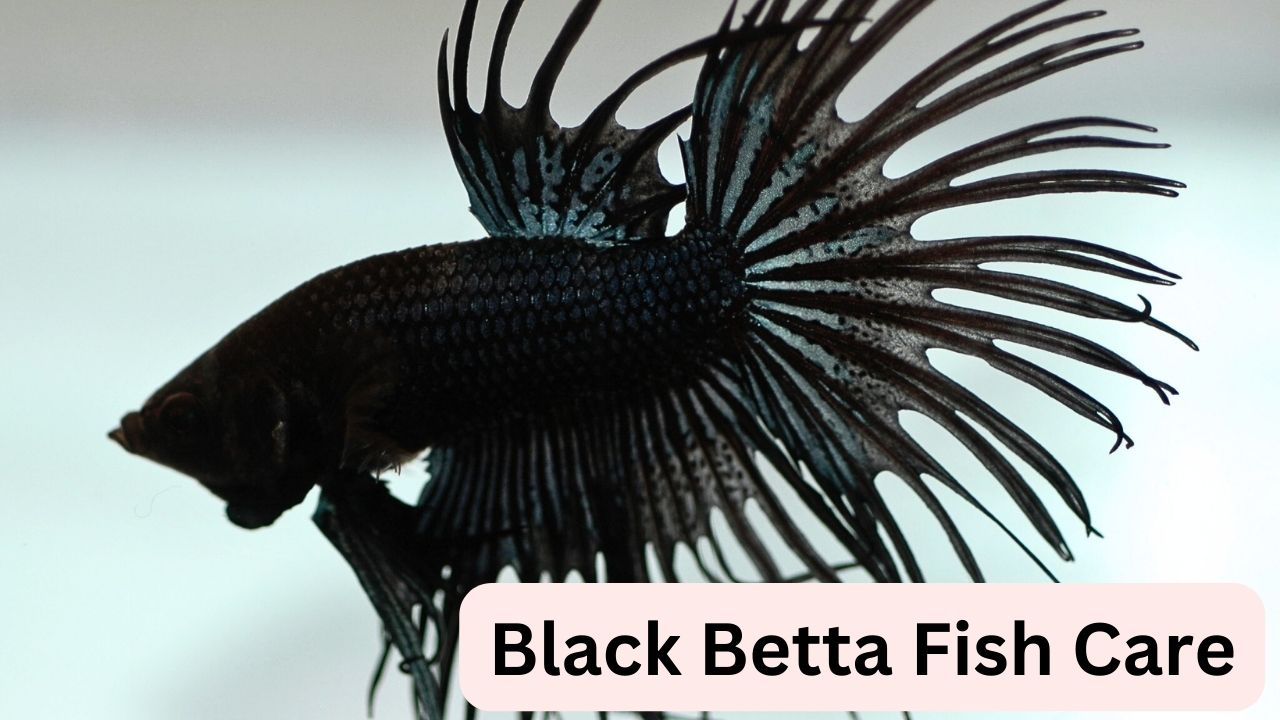Black Betta Fish Care
Introduction
I’m Cary, and today I’m talking about black betta fish care. We will discuss their health problems and solutions, Betta breeds and their diet, etc. If you have any doubts, please let me know.
Betta fish have long been popular pets thanks to their beautiful fins, lively personalities, and ease of care. Black bettas, in particular, make a striking addition with their glossy dark coloration. Caring for them takes some special considerations to keep them healthy and happy. Here is a complete guide to black betta fish care 2024.
Basic Information and Origin
Black bettas can be found in a few naturally occurring wild types, but most black varieties today are the result of selective breeding programs. Black is a recessive color in bettas, meaning both parents must carry the gene for black offspring to occur. Breeders hybridize certain color strains, like black copper, black lace, and black melanoma types, to intensify black pigmentation.
The origins of today’s black betta fish trace back to betta species native to the rice paddies and slow-moving streams of Thailand, Cambodia, and Vietnam. Wild betta habitats are shallow, warm, plant-filled waters – an environment that black betta fish still thrive in when kept as aquarium pets.
Black Betta Varieties
There are a few main types of black betta fish with varying shades of black, iridescence, and patterning:
Black Copper Betta
Black copper bettas have a black base layer with an iridescent copper-green shine. They may show some color in the fins as well.
Black Lace Betta
Black lace bettas have delicate black scaling over lighter colored finnage and bodies, creating a “lacy” look. They can be predominately black or lighter colored depending on lineage.
Black Melano Betta
Black Milano bettas are as dark as possible, ideally showing jet-black bodies and fins with little to no iridescence. They are created by selectively breeding fish with the most melanin.
Black Devil Betta
Black devil bettas exhibit a full black body and fins. Their most distinguishing feature is reddish eyes. This variety results from crossing black and red-eyed gene-carrying lines.
Black Betta Genetics
The genetics behind black coloration in bettas involves multiple genes interacting. Two important ones are the melanin gene and the non-red layering gene.
The melanin gene controls how much black pigment a betta produces. Both parents must carry this recessive gene to produce black offspring. Selectively breeding fish with the most melanin content has resulted in today’s intensely black varieties.
The non-red layering gene adds black over any red coloration in bettas when present. Breeding a black betta carrying this gene with a red betta can produce black devil varieties or black lace varieties depending on lineage.
Buy a Black Betta Fish
Black bettas are now readily available from specialty aquarium stores and betta breeders thanks to their recent surge in popularity. They typically cost between $15-$30.
When selecting a black betta, look for an active fish showing rich, even coloration with no signs of illness. Make sure the betta has clear eyes, intact flowing fins, and healthy body condition without skeletal protrusions.
Many breeders now ship black bettas nationwide, opening options beyond local stores. Online retailers specifically dedicated to bettas also carry various black varieties.
Black Betta Care
Caring for black betta fish requires paying special attention to their housing setup, nutritional needs, tank mates, and health. Their dark pigmentation makes them more prone to issues like fin biting, constipation, vision problems, and overheating. With proper adjustments to care, most challenges can be prevented.
Housing Requirements
Black bettas need certain tank conditions to truly thrive:
Tank Size
- Minimum 2.5 gallons, ideally 5 gallons or more
Temperature
- 78-82°F to mimic tropical origins
Filtration
- Low-flow filter designed for bettas
Plants & Decor
- Broadleaf plants like anubias or java fern
- Floating plants to provide resting spots near the surface
- Caves, tunnels, and hammocks in darker colors they can easily see
Substrate
- Dark natural colors like black or brown
Lid
- Necessary to prevent jumping (these active fish can leap out!)
Bare glass tanks should be avoided as should bright colors that could overwhelm black bettas’ vision. Plenty of hiding spots and resting areas near the top are important to support their natural behaviors. Room to safely divide territory between multiple males is also essential.
For community tanks, increase the minimum size to 10 gallons or more depending on tank mates. Heavily planted set-ups are best to provide visual barriers and territory markers.
Water Parameters
Ideal water parameters for black bettas:
- Temperature: 78-82°F
- pH: 6.8-7.6
- Hardness: 5-10 dGH
- Ammonia, nitrites: 0 ppm
- Nitrates less than 20 ppm
A cycled tank is crucial along with partial water changes of 25-50% each week to control nitrates. Use a water conditioner to remove chlorine and chloramines whenever changing water.
Feeding Black Bettas
Feed is the most important thing in black betta fish care, black betta fish require more calories than light-colored varieties due to increased melanin production. They are also more prone to constipation which can cause serious health problems. Careful diet management avoids problems.
Diet Requirements
Feed adult black bettas 1-2 small meals per day based on the following nutrition profile:
- At least 40% of protein sources
- At least 20% vegetation/fiber sources
- Limited starch binders like wheat can cause constipation issues
Food Types
Some healthy food options include:
- Blackworms
- Brine shrimp
- Daphnia
- Blood worms
- Larval shrimp
- Crickets
- Mosquito larvae
- Quality betta pellets high in insect ingredients
Soaking pellets before feeding softens them up for digestion while using a mixture of frozen and live prey provides essential variety. Feeding tubes with small openings also help prevent bettas from gulping too much air along with food, reducing swim bladder problems.
Tank Mates
Black bettas can be kept with non-aggressive community fish in larger planted tanks, but male bettas will need to be separated from each other via dividers. Some possible tank mates include:
- Small rasboras
- Corydoras catfish
- Tetras
- Bristle nose plecos
- Shrimp
- Snails
- African dwarf frogs
Males may still challenge tank mates with lengthy fins like guppies. Avoid fin nippers like tiger barbs that will damage betta tails. Introduce any new tank mates slowly and provide hiding spots for each species.
Black Betta Fish Health
Common Illnesses
Some health issues black bettas are prone to include:
Constipation – From difficulty digesting low-quality foods. Avoid with proper diet and frequent water changes. Can cause swim bladder disorders, fin damage, and lethargy.
Fin Biting – Results from boredom or stress. Enrich the environment and reduce tankmates. Usually, fins grow back if infection is prevented.
Blindness – Overbreeding for black pigments can result in vision loss over time. Ensure proper lighting that isn’t too harsh.
Temperature Sensitivity – Easily overheat due to coloration absorbing warmth. Maintain stable cooler temperatures below 82°F.
Preventative Care
Follow these guidelines for optimal health:
- Quarantine new arrivals for 3-4 weeks
- Disinfect equipment between uses
- Test water parameters frequently
- Hold the handler’s hands before tank work
- Observe fish daily for signs of disease
Medications like antifungals, antibiotics, para guard, and jungle fungus treat common fungal and bacterial infections. Aquarium salt and Epsom salt baths provide relief for constipation and inflammation issues.
Breeding Black Betta Fish Care
Breeding black bettas takes some effort but allows home aquarists to produce more affordable black varieties. Start with known black gene-carrying lines showing strong black traits. Spawning requires conditioning pairs separately with protein-rich live foods before introducing them for mating. Fry can be difficult to feed at first – frequent small meals of microscopic foods like infusoria growing in the tank usually yield the best results with grow-outs. Juveniles reach full color around 3-4 months old. Selectively breeding the darkest individuals intensifies black color over generations.
Conclusion
Caring for the stylish black betta fish involves some special requirements compared to brightly colored varieties, but following best practices makes success easier. Such as spacious, rich tank setups designed around their vision, water parameters to suit their tropical environment, nutritionally balanced diet high in insect content
Careful preventive care and prompt treatment when health problems arise. For breeders, selectively intensifying dark pigmentation from generation to generation.
Do your research, provide proper housing, and get to know your Black Betta’s personality—soon you’ll have a show-stopping underwater pet thriving under your care!
FAQs
What size tank do black bettas need?
Black bettas need a minimum tank size of 2.5 gallons but ideally 5 gallons or more. Bigger is always better for an active fish like a betta to provide adequate territory and enrichment.
How often should you feed black bettas?
Feed adult black bettas 1-2 small meals daily. Overfeeding can cause serious digestive issues for black varieties more prone to constipation.
Why are my black betta’s fins clamped?
Clamped fins signal stress or illness. Test water parameters and treat them appropriately. Reduce tankmate conflict and enrich the environment. Consult a veterinarian if fins stay clamped over 24 hours.
Can black betta fish change color?
Yes, black bettas can change color over time, especially darker black strains like melanoma types. Water parameters impact color – keep nitrogen levels low. Fins tend to lighten fastest as the fish age.
How can you tell a black betta’s gender?
Males have longer ventral fins, brighter colors, bubble bubble-nesting behavior. Females have short ventral fins, duller coloration, and visible egg spots near the anal fin. Look for distinctive beard-like gill covers on mature males.



2 thoughts on “Black Betta Fish Care 2024”